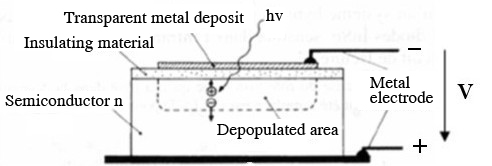
Noise quantification
In this paragraph, we offer a description of the main sources of noise and of their respective influence on the signal's quality.
Read noise
The read noise is due to the fluctuations of photocharges at the terminals of the MOS capacitor constituted by the pixel (figure 34).

The charge fluctuation at the terminals of a capacity C is given by the relation:

in which k the Boltzmann constant
 and T is the temperature. The number of thermal electrons emitted in C makes up the read noise. It is calculated in Root Main Square (RMS).
and T is the temperature. The number of thermal electrons emitted in C makes up the read noise. It is calculated in Root Main Square (RMS).
We have:

For instance, if C = 50 pF, then:
-
 = 2840 electrons at T = 230 K
= 2840 electrons at T = 230 K -
 = 2709 electrons at T = 273 K
= 2709 electrons at T = 273 K -
 = 2503 electrons at T = 233 K
= 2503 electrons at T = 233 K -
 = 46 electrons at T = 77 K
= 46 electrons at T = 77 K -
 = 10 electrons at T = 4 K
= 10 electrons at T = 4 K
We can notice that at room temperature, the number of electrons due to the read noise is significant and that we'd better cool the sensor down in order to limit its value.
The read noise determines the pixel storage dynamics. Indeed, the storage capacity is equal to
 . Then, the storage dynamics is defined by:
. Then, the storage dynamics is defined by:
The storage dynamics is proportional to the voltage applied on the pixel.
Dark noise
It depends on the charge accumulation duration, I.E on the sensor integration time, and on the number of sensor's dark electrons by second. Then, we get the relation :

Photon noise
The photon noise is due to the light's quantum nature. A flow of photons can be compared to a flow of particles coming to the detector (a pixel) with a rate nph. Thus, this flow generates during a duration tINT a number of photons equal to Nph = n phtINT.
The probability of detecting n photons during the integration time tINT follows a Poisson distribution, meaning that:
This average value of this noise is equal to:
and the statistics variance is:
The photon fluctuation is then expressed in root of the number of photons. For an light flow F incident on the pixel, we deduce the number of photoelectrons of the photon noise expressed by:
with:
-
Planck's constant: h = 6,6256x10-34 J.s
-
light velocity: c = 299792458 m.s-1
-
 pixel quantum efficiency
pixel quantum efficiency -
 light wavelength
light wavelength
Digitization noise
The digitization noise depends on the number of saturation electron (Nsat) and on the number of digitization bits (Nbits). For a quantizing level
 , the statistics of the quantizing error is a uniform distribution on
, the statistics of the quantizing error is a uniform distribution on
 , whose variance is
, whose variance is
 . The number of quantizing levels is equal to
. The number of quantizing levels is equal to
 . The number of electrons corresponding to a quantizing level is thus equal to:
. The number of electrons corresponding to a quantizing level is thus equal to:
We can deduce from this relation the expression of the quantizing noise: